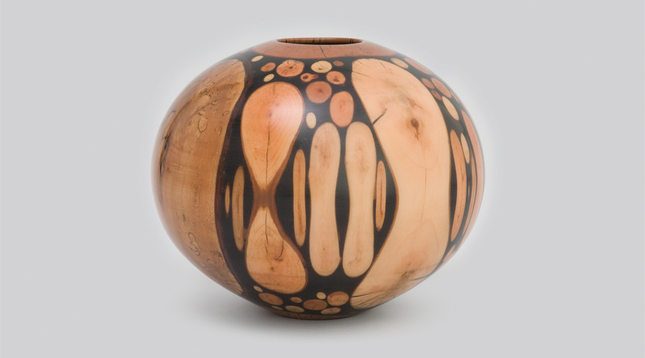
Courtesy Ruth and David Waterbury. Photographs by Robert Fogt.
Using woods indigenous to the southeastern United States, the Georgia-born Philip Moulthrop employs a composite technique that yields a mosaic effect. Bundled Mosaic, 1999, is made of wild black cherry and red maple.
View full image

Courtesy Ruth and David Waterbury. Photographs by Robert Fogt.
Using woods indigenous to the southeastern United States, the Georgia-born Philip Moulthrop employs a composite technique that yields a mosaic effect. Bundled Mosaic, 1999, is made of wild black cherry and red maple.
View full image
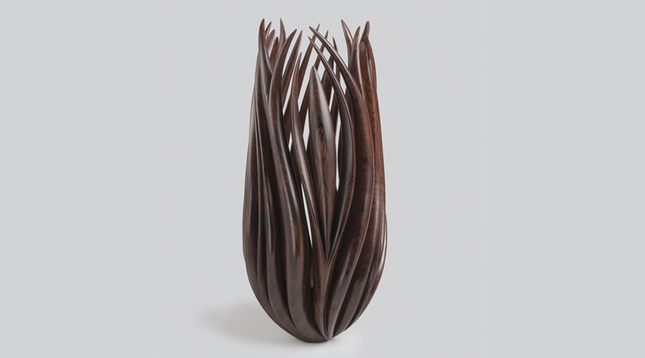
Courtesy Ruth and David Waterbury. Photographs by Robert Fogt.
Taking inspiration from nature, the Southern California–based William Hunter uses a lathe and disc to transform hard tropical woods into abstract, organic forms. Spiral and movement are central to his creative vision. Garden Songs, 2004, carved from cocobolo wood, evokes tall grasses in the wind.
View full image

Courtesy Ruth and David Waterbury. Photographs by Robert Fogt.
Taking inspiration from nature, the Southern California–based William Hunter uses a lathe and disc to transform hard tropical woods into abstract, organic forms. Spiral and movement are central to his creative vision. Garden Songs, 2004, carved from cocobolo wood, evokes tall grasses in the wind.
View full image

Courtesy Ruth and David Waterbury. Photographs by Robert Fogt.
Canadian wood turner Michael Hosaluk brings a sense of lyricism and playfulness to his material, inviting interaction. In such works as Family, 1998, made of maple painted with acrylic, he allows viewers to arrange the different pieces as they see fit.
View full image

Courtesy Ruth and David Waterbury. Photographs by Robert Fogt.
Canadian wood turner Michael Hosaluk brings a sense of lyricism and playfulness to his material, inviting interaction. In such works as Family, 1998, made of maple painted with acrylic, he allows viewers to arrange the different pieces as they see fit.
View full image
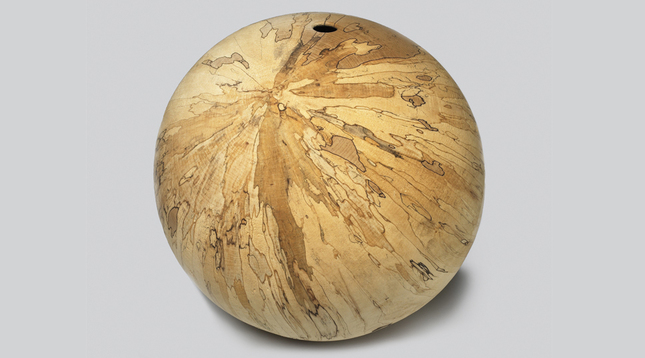
Courtesy Ruth and David Waterbury. Photographs by Robert Fogt.
David Ellsworth’s Lunar Sphere, 2000, made of spalted sugar maple, is a prime example of the way wood turners can create forms that emphasize the natural patterns and marks in the material. Here, the grain is used in the service of geometry, to underscore the spherical shape of the object. The entire form was hollowed out through the tiny hole at the top.
View full image

Courtesy Ruth and David Waterbury. Photographs by Robert Fogt.
David Ellsworth’s Lunar Sphere, 2000, made of spalted sugar maple, is a prime example of the way wood turners can create forms that emphasize the natural patterns and marks in the material. Here, the grain is used in the service of geometry, to underscore the spherical shape of the object. The entire form was hollowed out through the tiny hole at the top.
View full image
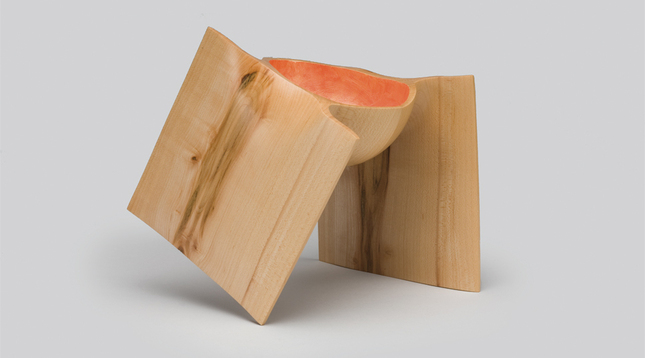
Courtesy Ruth and David Waterbury. Photographs by Robert Fogt.
Stephen Hogbin’s Walking Bowl, 1999, carved from maple, exemplifies how patterns in the wood can condition the outcome of a vessel’s form. And, by giving the piece a sense of movement, Hogbin reintroduces the vessel as an active, rather than passive, object.
View full image

Courtesy Ruth and David Waterbury. Photographs by Robert Fogt.
Stephen Hogbin’s Walking Bowl, 1999, carved from maple, exemplifies how patterns in the wood can condition the outcome of a vessel’s form. And, by giving the piece a sense of movement, Hogbin reintroduces the vessel as an active, rather than passive, object.
View full image
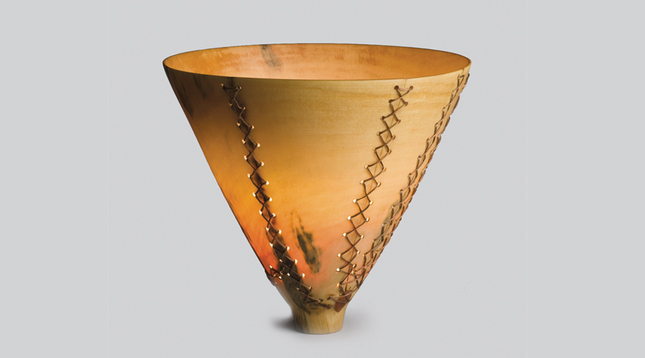
Courtesy Ruth and David Waterbury. Photographs by Robert Fogt.
The artist who inspired the Waterburys to start collecting is Ron Kent, known for turning vessels with ultrathin, translucent walls. His Post-Nuclear Series evolved after one of the fragile objects broke. A friend who is a fiber artist suggested he lace it, so he punctured holes in the wood and she stitched it together. This 2005 piece, turned from Norfolk Island pine, is part of the Post-Nuclear Series and was created in collaboration with his wife, Myra Kent. He laced it together (after accidentally knocking it onto the floor) at the suggestion of the Waterburys.
View full image

Courtesy Ruth and David Waterbury. Photographs by Robert Fogt.
The artist who inspired the Waterburys to start collecting is Ron Kent, known for turning vessels with ultrathin, translucent walls. His Post-Nuclear Series evolved after one of the fragile objects broke. A friend who is a fiber artist suggested he lace it, so he punctured holes in the wood and she stitched it together. This 2005 piece, turned from Norfolk Island pine, is part of the Post-Nuclear Series and was created in collaboration with his wife, Myra Kent. He laced it together (after accidentally knocking it onto the floor) at the suggestion of the Waterburys.
View full image
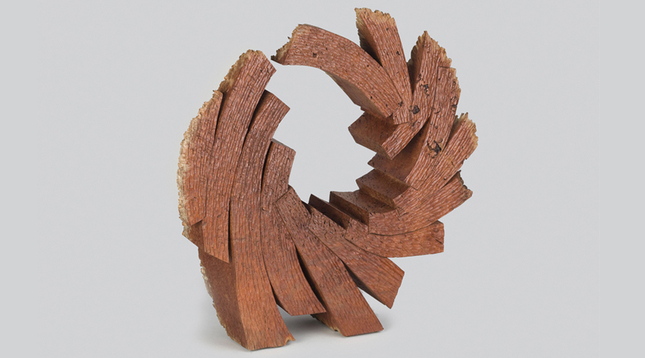
Courtesy Ruth and David Waterbury. Photographs by Robert Fogt.
Arkansas artist Robyn Horn uses a chainsaw to sculpt abstract shapes that play with balance and gravity, positive and negative space. Works like the jarrah-burl wood Full Circle (2005), from her Slipping Stone Series, blend the geometry of modernism with the totemic power of tribal art.
View full image

Courtesy Ruth and David Waterbury. Photographs by Robert Fogt.
Arkansas artist Robyn Horn uses a chainsaw to sculpt abstract shapes that play with balance and gravity, positive and negative space. Works like the jarrah-burl wood Full Circle (2005), from her Slipping Stone Series, blend the geometry of modernism with the totemic power of tribal art.
View full image
Is wood sculpting an art or a craft? Since 1976, when wood turners from around the country gathered for the first time, at a symposium in Pennsylvania, the field of wood art has evolved from a disconnected group of what most would call hobbyist artisans into a group of devoted sculptors, many of whom now have work in major museums and private collections. Ruth and David Waterbury ’58 purchased their first piece of wood art—almost on a whim—in 1984, a time when amassing a collection would have seemed inconceivable. But they were hooked. Today, about 80 pieces from their collection of more than 500 works, dating from the mid-1980s to the mid-2000s, are on display in an exhibit at the Yale University Art Gallery, Conversations with Wood.
Wood art, a broad term encompassing turning (with a lathe), carving, and any variety of other methods, only achieved critical prominence in the 1980s and ’90s. The mid-century had seen other crafts, such as ceramics, glassblowing, and textile arts, start on a modern, cutting-edge trajectory. But for a long time, wood was limited to furniture design and hobbyist pieces. “Wood art was really kind of late to the ball,” says Jennifer Komar Olivarez, associate curator of decorative arts at the Minneapolis Institute of Art, where the exhibition was assembled. Until the 1970s, the field had no organizing force, and therefore no critical mass or institutional support. But once collectors like the Waterburys threw their patronage and passion behind the art, it blossomed. “They were pivotal,” says Patricia Kane ’87PhD, curator of decorative arts at the Yale University Art Gallery.
What strikes the viewer most about the current exhibition is how the artists manipulate the textures, marks, and patterns of different woods to yield highly individual forms. Some are utilitarian and veer more toward “craft,” some nonfunctional and understandable more as “art”—categories that can be rather blurry in this field. But as Olivarez points out, the makers all have “artistic motivations, even if the forms are functional.”
Even the most utilitarian forms can accommodate surprisingly individual approaches. In some of the best examples of wood turning, by such artists as Bob Stocksdale, Ed and Philip Moulthrop, and Ron Kent, strikingly skillful handiwork merges with creativity and expression to reach a satisfying convergence of art and craft. David Ellsworth uses the lathe and other tools to create more-abstract vessels, which show only a faint connection, if any, to utility. Some of his best works incorporate decay into the design, contrasting rotted or fungus-eaten sections with pristine wood; the resulting fragile works convey a determined embrace of mortality.
At the other end of the spectrum are the abstract geometric sculptures of such artists as Robyn Horn. Wood turners don’t often leave obvious traces of their hand, but although Horn comes out of the wood-turning tradition, she leaves her mark with a chainsaw. The carving and slicing of her saw evoke the gestural power of abstract expressionism, while the grooves left by the saw’s teeth read like brushstrokes might.
Yet Horn’s art is as much about the wood’s natural characteristics as her own impact on it—a principle at the core of every piece in the Waterburys’ collection. In this work, the wood is not incidental to the art. It is the guide for, and into, the art.
Using woods indigenous to the southeastern United States, the Georgia-born Philip Moulthrop employs a composite technique that yields a mosaic effect. Bundled Mosaic, 1999, is made of wild black cherry and red maple.
 loading
loading